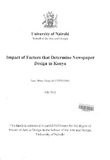| dc.description.abstract | Newspapers in Kenya have experienced a gradual metamorphosis in terms of typography and overall graphics. Change of lifestyle and patterns of information retrieval have created readers who do not have time to absorb media in a linear, front- to-back-of-the paper way. Most readers are interested in the gist of the story. Kenyan newspaper publishers therefore have an obligation to cater for these readers by packaging content that will be reader friendly, relevant and graphically appealing. 'The days of taking the reader for granted are past. 'I Production of more attractively designed newspapers has led to greater recognition of design and designers in Kenya today. Prior to the 1970s design did not play an important role as today.
In Kenya's newspaper industry, each publication seeks to establish an identity. Aggressive marketing techniques are being used and changed periodically to keep publications afloat. This study will explore the role design plays in influencing this change. The cost of publishing a newspaper and marketing it requires an investment by the publisher, and before the paper is established in the market, it may take the publisher quite a while to recoup the investment, let alone make a profit. Even worse is where a newspaper ends up not selling as expected and the publisher is forced to dispose off copies that are not sold for paper recycling procedures.
In book publishing, often the authors look at the direct costs of publishing a book which may include editing, layout and design and print costs. But there are other costs such as warehousing, insurance, marketing and distribution that many outside the publishing field overlook when thinking of profitability of the enterprise. Competition from different media including some unlicensed or so called 'gutter press' publications is creating an aggressive approach to redesigning newspapers. There has been interesting debate on the effectiveness of the gutter press. This research also sheds light on this topic.
Fifteen years ago a Kenyan newspaper had a couple of black and white photographs alongside a mundane layout which included pages cluttered with text that was visually strenuous. Over this period interesting changes in design have taken place. Today's newspaper has multiple colored photographs with an exclusive layout. There is a greater awareness of graphics among newspaper designers/publishers and readers today. The need for newspaper publishers to produce more graphically appealing pages in order to maintain a captivated audience is a concern to them and most media houses who wish to stay afloat with their publications. At the same time there seems to be a change in reading trends which are shifting from print to electronic 'online news readers'.
New media poses threat to the print media. Further, statistics are indicating a decline in print newspaper readers. It has been established in Kenya, that after completion of formal education many people either lose interest in avid reading or do not have adequate time to read.
This research investigates the impact of factors that determine newspaper design in Kenya. Over 250 respondents were engaged in informal interviews and issued with questionnaires which were later collected and analysed.
Four key informants involved in newspaper production and distribution were interviewed. Reference from relevant literature, newspapers, photographs, illustrations, archival information and general observation proved to be successful ways of collecting the data which has been documented.
The research design is presented in three steps:
1. Exploration- a relatively unstructured investigation in which the researcher attempts to define the problem of newspaper design in Kenya more specifically and determines how the research task will be carried out.
2. Data collection- actual data gathering from simple observation to field interviews 3. Analysis and interpretation of results --- after the field work is done. Various measures and findings of the analysis have been presented. Chapter one introduces the subject, traces the background and context of the problem of design issues and newspapers and outlines the objectives of the study. Chapter two covers literature review and highlights issues to do with perception of design and its relationship with newspapers, aspects of design and factors that determine newspaper design.
Chapter two also dwells on role of advertising, new media and technology in newspapers and delves into the Kenyan scenario in newspaper design. Chapter three describes methodology of the study. Findings and analysis are discussed in chapter four and chapter five concludes on the findings, analysis and makes recommendations on some key areas especially on the new media and technological arena.
This research was carried out in Nairobi and specifically in three areas that were zoned as Langata, Adams Arcade and Kibera. These zones represent three different social groups. The research has given emphasis to Kibera and its environs and most analysis sampled from this zone. | en_US |

